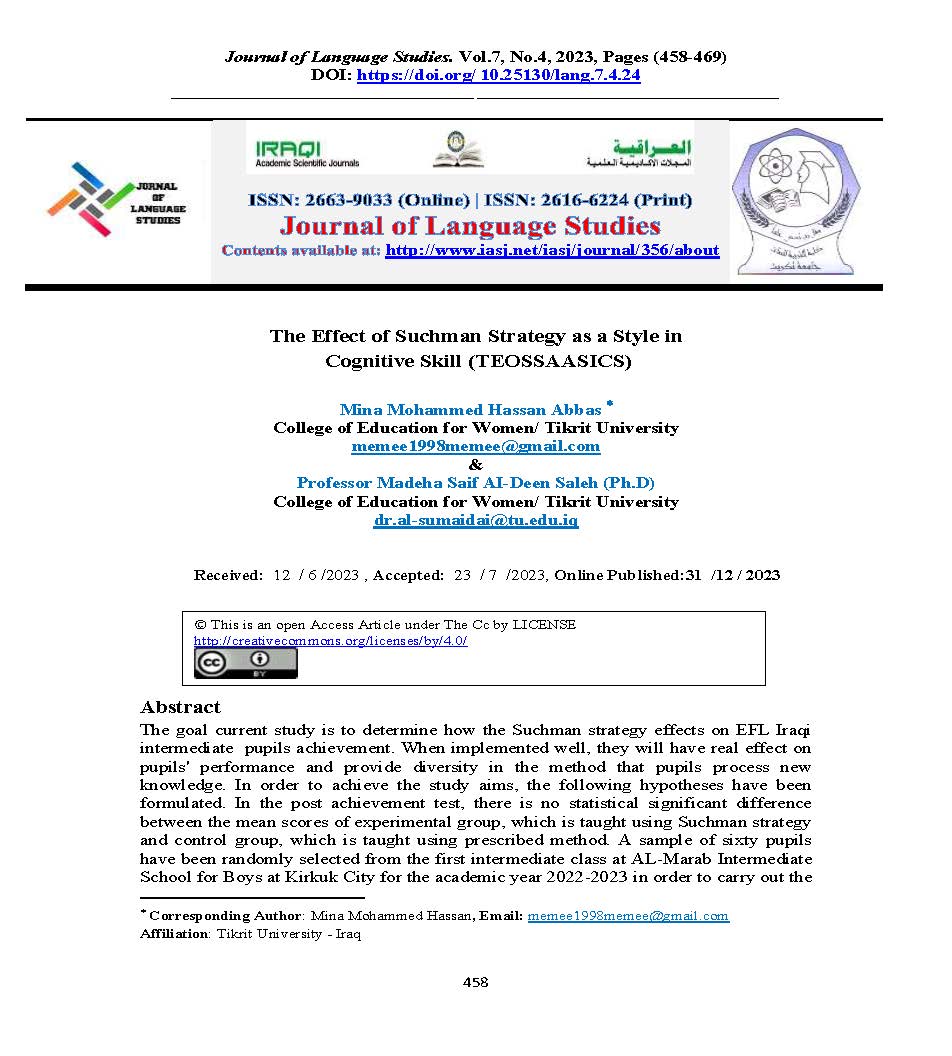The Effect of Suchman Strategy as a Style in Cognitive Skill (TEOSSAASICS)
DOI:
https://doi.org/10.25130/lang.7.4.24Keywords:
strategy, prescribed, scores, experimental group, control groupAbstract
The goal current study is to determine how the Suchman strategy effects on EFL Iraqi intermediate pupils achievement. When implemented well, they will have real effect on pupils' performance and provide diversity in the method that pupils process new knowledge. In order to achieve the study aims, the following hypotheses have been formulated. In the post achievement test, there is no statistical significant difference between the mean scores of experimental group, which is taught using Suchman strategy and control group, which is taught using prescribed method. A sample of sixty pupils have been randomly selected from the first intermediate class at AL-Marab Intermediate School for Boys at Kirkuk City for the academic year 2022-2023 in order to carry out the pupils' and validate its assumptions. Both groups are equalized in some important factors including educational levels of the parents, the age of pupils', their test results from their previous schooling year, and their pretest scores for both groups. The researcher himself has taught both groups. The two groups are equally divided into the experimental group, group (A), that made up of (30) pupils which have been taught according to the Suchman strategies. The control group, group (B), made up of (30) pupils which have been taught according to the prescribed method. According to the results, there is a statistically significant difference between the mean scores of the experimental group in the pre-test achievement. Moreover, the pupils in the experimental group were guided by the Suchman strategy to attain better achievement at the post tests. Finally, appropriate conclusions, recommendations and suggestions for further studies are put forward.
References
Ali, A. (1992) Inquiry education: its theoretical origins and practical applications. 2nd
edition, National Scientific Research Authority, Tripoli vol.
Amjah, Y. (2014).A study of Teachers' Strategies So Develop Students' Interest Towards Learning English as a Second Language. Procedia-Social and Behavioural Sciences: University Brune Darussalam.
Arends, R. and Kilcher, A. (2010).Teaching for Students Learning Becoming an
Accomplished Teacher. Routledge, Taylor and Franic Group: New York.
Arikunto, S. (2006). Research Procedure: A Practical Approach. Jakarta: Rineka
Create.
Atallah, M. K. (2001). Methods and Styles of teaching science. 2nd edition, Amman
Dar Al-Maysarah for publication and distribution.
Ausubel D. P., Novak, J. D., Hanesian, H. (1978). Educational Psychology: A
Cognitive View", 2nd ed.; Holt, Rinehart, Winston: New York.
Burns, R. B., and Dobson, C.B. (1981). Experimental Psychology: Research
Method and Statistics. MTP Press Limited.England: International Medical
Publisher. 49(2) 427
Davies, A. (1990). Principles of Language Testing. Cambridge Blackwell, Ltd.
Hamdy, A. (2009). "The effectiveness of using suchman survey model in achievement
Mathematics and the development of mathematical thinking among high school
student Al-Azha", an unpublished master’s thesis, Faculty of Education in Al-
Wadi New, Assiut University.
Hanlon, B. and Larget, B. (2011). Samples and Population. Madison: University of
Wisconsin.
Hussein, H. (1999) Teaching Design: A Systems View, Book II, Volume 1,
Available here. World of Books, Cairo.
Joyce, B. and Weil, M. (1996). Models of Teaching.5th ed. Prentice-Hall of India:
New Delhi.
Qatami, Y., and Qatami, N. (1993). Classroom Teaching Models. Amman: Dar AL-
Shuruq.
Zaitoun, H. (2001).Teaching skills Vision in the implementation of teaching. 1stfloor,
Tanta: Ola Bookshop for publication and distribution.

Downloads
Published
Versions
- 2023-12-31 (2)
- 2023-12-31 (1)
